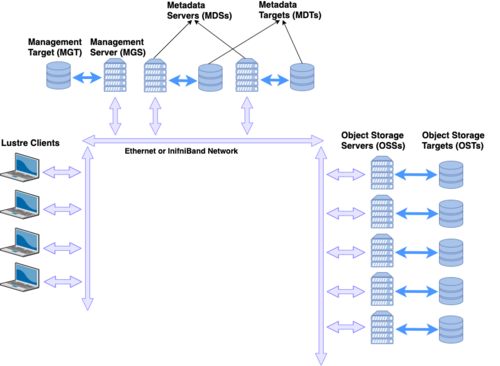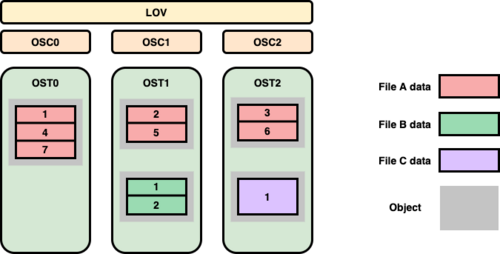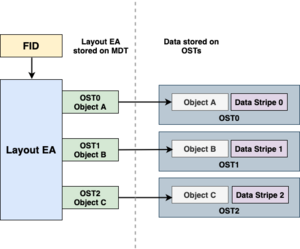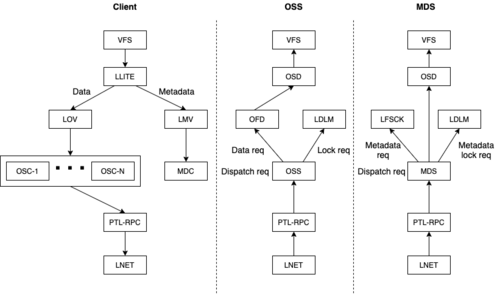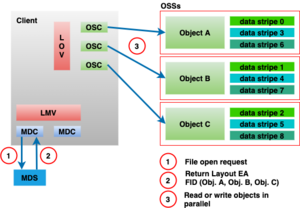Understanding Lustre Internals: Difference between revisions
| Line 271: | Line 271: | ||
When the MGC module initializes, it registers MGC as an obd device type with Lustre using <code>class_register_type()</code> as shown in Source Code [[#code:class_register_type|[code:class_register_type]]]. Obd device data and metadata operations are defined using the <code>obd_ops</code> and <code>md_ops</code> structures respectively. Since MGC deals with metadata in Lustre, it has only <code>obd_ops</code> operations defined. However the metadata client (MDC) has both metadata and data operations defined since the data operations are used to implement Data on Metadata (DoM) functionality in Lustre. The <code>class_register_type()</code> function passes <code>&mgc_obd_ops</code>, <code>NULL</code>, <code>false</code>, <code>LUSTRE_MGC _NAME</code>, and <code>NULL</code> as its arguments. <code>LUSTRE_MGC_NAME</code> is defined as <code>“mgc”</code> in <code>include/obd.h</code>. | When the MGC module initializes, it registers MGC as an obd device type with Lustre using <code>class_register_type()</code> as shown in Source Code [[#code:class_register_type|[code:class_register_type]]]. Obd device data and metadata operations are defined using the <code>obd_ops</code> and <code>md_ops</code> structures respectively. Since MGC deals with metadata in Lustre, it has only <code>obd_ops</code> operations defined. However the metadata client (MDC) has both metadata and data operations defined since the data operations are used to implement Data on Metadata (DoM) functionality in Lustre. The <code>class_register_type()</code> function passes <code>&mgc_obd_ops</code>, <code>NULL</code>, <code>false</code>, <code>LUSTRE_MGC _NAME</code>, and <code>NULL</code> as its arguments. <code>LUSTRE_MGC_NAME</code> is defined as <code>“mgc”</code> in <code>include/obd.h</code>. | ||
<span id="code:class_register_type" label="code:class_register_type">[Source code:class_register_type() function defined in obdclass/genops.c]</span> | <span id="code:class_register_type" label="code:class_register_type">[Source code:class_register_type() function defined in obdclass/genops.c]</span> | ||
<syntaxhighlight lang="C"> | |||
<syntaxhighlight lang="C | |||
int class_register_type(const struct obd_ops *dt_ops, | int class_register_type(const struct obd_ops *dt_ops, | ||
const struct md_ops *md_ops, | const struct md_ops *md_ops, | ||
Revision as of 10:49, 23 November 2021
Lustre Architecture
What is Lustre?
Lustre is a GNU General Public licensed, open-source distributed parallel file system developed and maintained by DataDirect Networks (DDN). Due to the extremely scalable architecture of the Lustre file system, Lustre deployments are popular in scientific supercomputing, as well as in the oil and gas, manufacturing, rich media, and finance sectors. Lustre presents a POSIX interface to its clients with parallel access capabilities to the shared file objects. As of this writing, Lustre is the most widely used file system on the top 500 fastest computers in the world. Lustre is the file system of choice on 7 out of the top 10 fastest computers in the world today, over 70% of the top 100, and also for over 60% of the top 500.[1]
Lustre Features
Lustre is designed for scalability and performance. The aggregate storage capacity and file system bandwidth can be scaled up by adding more servers to the file system, and performance for parallel applications can often be increased by utilizing more Lustre clients. Some practical limits are shown in Table 1 along with values from known production file systems.
Lustre has several features that enhance performance, usability, and stability. Some of these features include:
- POSIX Compliance: With few exceptions, Lustre passes the full POSIX test suite. Most operations are atomic to ensure that clients do not see stale data or metadata. Lustre also supports mmap() file IO.
- Online file system checking: Lustre provides a file system checker (LFSCK) to detect and correct file system inconsistencies. LFSCK can be run while the file system in online and in production, minimizing potential downtime.
- Controlled file layouts: The file layouts that determine how data is placed across the Lustre servers can be customized on a per-file basis. This allows users to optimize the layout to best fit their specific use case.
- Support for multiple backend file systems: When formatting a Lustre file system, the underlying storage can be formatted as either ldiskfs (a performance-enhanced version of ext4) or ZFS.
- Support for high-performance and heterogeneous networks: Lustre can utilize RDMA over low latency networks such as Infiniband or Intel OmniPath in addition to supporting TCP over commodity networks. The Lustre networking layer provides the ability to route traffic between multiple networks making it feasible to run a single site-wide Lustre file system.
- High-availability: Lustre supports active/active failover of storage resources and multiple mount protection (MMP) to guard against errors that may results from mounting the storage simultaneously on multiple servers. High availability software such as Pacemaker/Corosync can be used to provide automatic failover capabilities.
- Security features: Lustre follows the normal UNIX file system security model enhanced with POSIX ACLs. The root squash feature limits the ability of Lustre clients to perform privileged operations. Lustre also supports the configuration of Shared-Secret Key (SSK) security.
- Capacity growth: File system capacity can be increased by adding additional storage for data and metadata while the file system in online.
| Feature | Current Practical Range | Known Production Usage |
|---|---|---|
| Client Scalability | 100 - 100,000 | 50,000+ clients, many in the 10,000 to 20,000 range |
| Client Performance | Single client: 90% of network bandwidth Aggregate: 10 TB/s |
Single client: 4.5 GB/s (FDR IB, OPA1), 1000 metadata ops/sec Aggregate: 2.5 TB/s |
| OSS Scalability | Single OSS: 1-32 OSTs per OSS Single OST (ldiskfs): 300M objects, 256TiB per OST Single OST (ZFS): 500M objects, 256TiB per OST OSS count: 1000 OSSs w/ up to 4000 OSTs |
Single OSS (ldiskfs): 32x8TiB OSTs per OSS, 8x32TiB OSTs per OSS Single OSS (ZFS): 1x72TiB OST per OSS OSS count: 450 OSSs w/ 1000 4TiB OSTs, 192 OSSs w/ 1344 8TiB OSTs, 768 OSSs w/ 768 72TiB OSTs |
| OSS Performance | Single OSS: 15 GB/s Aggregate: 10 TB/s |
Single OSS: 10 GB/s Aggregate: 2.5 TB/s |
| MDS Scalability | Single MDS: 1-4 MDTs per MDS Single MDT (ldiskfs): 4 billion files, 8 TiB per MDT Single MDT (ZFS): 64 billion files, 64 TiB per MDT MDS count: 256 MDSs w/ up to 265 MDTs |
Single MDS: 3 billion files MDS count: 7 MDSs w/ 7x 2 TiB MDTs in production (256 MDSs w/ 256 64 GiB MDTs in testing) |
| MDS Performance | 50,000 create ops/sec, 200,000 metadata stat ops/sec |
15,000 create ops/sec, 50,000 metadata stat ops/sec |
| File system Scalability | Single File (max size): 32 PiB (ldiskfs) or 263 bytes (ZFS) Aggregate: 512 PiB total capacity, 1 trillion files |
Single File (max size): multi-TiB Aggregate: 55 PiB capacity, 8 billion files |
Lustre Components
Lustre is an object-based file system that consists of several components:
- Management Server (MGS) - Provides configuration information for the file system. When mounting the file system, the Lustre clients will contact the MGS to retrieve details on how the file system is configured (what servers are part of the file system, failover information, etc.). The MGS can also proactively notify clients about changes in the file system configuration and plays a role in the Lustre recovery process.
- Management Target (MGT) - Block device used by the MGS to persistently store Lustre file system configuration information. It typically only requires a relatively small amount of space (on the order to 100 MB).
- Metadata Server (MDS) - Manages the file system namespace and provides metadata services to clients such as filename lookup, directory information, file layouts, and access permissions. The file system will contain at least one MDS but may contain more.
- Metadata Target (MDT) - Block device used by an MDS to store metadata information. A Lustre file system will contain at least one MDT which holds the root of the file system, but it may contain multiple MDTs. Common configurations will use one MDT per MDS server, but it is possible for an MDS to host multiple MDTs. MDTs can be shared among multiple MDSs to support failover, but each MDT can only be mounted by one MDS at any given time.
- Object Storage Server (OSS) - Stores file data objects and makes the file contents available to Lustre clients. A file system will typically have many OSS nodes to provide a higher aggregate capacity and network bandwidth.
- Object Storage Target (OST) - Block device used by an OSS node to store the contents of user files. An OSS node will often host several OSTs. These OSTs may be shared among multiple hosts, but just like MDTs, each OST can only be mounted on a single OSS at any given time. The total capacity of the file system is the sum of all the individual OST capacities.
- Lustre Client - Mounts the Lustre file system and makes the contents of the namespace visible to the users. There may be hundreds or even thousands of clients accessing a single Lustre file sysyem. Each client can also mount more than one Lustre file system at a time.
- Lustre Networking (LNet) - Network protocol used for communication between Lustre clients and servers. Supports RDMA on low-latency networks and routing between heterogeneous networks.
The collection of MGS, MDS, and OSS nodes are sometimes referred to as the “frontend”. The individual OSTs and MDTs must be formatted with a local file system in order for Lustre to store data and metadata on those block devices. Currently, only ldiskfs (a modified version of ext4) and ZFS are supported for this purpose. The choice of ldiskfs or ZFS if often referred to as the “backend file system”. Lustre provides an abstraction layer for these backend file systems to allow for the possibility of including other types of backend file systems in the future.
Figure 1 shows a simplified version of the Lustre file system components in a basic cluster. In this figure, the MGS server is distinct from the MDS servers, but for small file systems, the MGS and MDS may be combined into a single server and the MGT may coexist on the same block device as the primary MDT.
Lustre File Layouts
Lustre stores file data by splitting the file contents into chunks and then storing those chunks across the storage targets. By spreading the file across multiple targets, the file size can exceed the capacity of any one storage target. It also allows clients to access parts of the file from multiple Lustre servers simultaneously, effectively scaling up the bandwidth of the file system. Users have the ability to control many aspects of the file’s layout by means of the lfs setstripe command, and they can query the layout for an existing file using the lfs getstripe command.
File layouts fall into one of two categories:
- Normal / RAID0 - File data is striped across multiple OSTs in a round-robin manner.
- Composite - Complex layouts that involve several components with potentially different striping patterns.
Normal (RAID0) Layouts
A normal layout is characterized by a stripe count and a stripe size. The stripe count determines how many OSTs will be used to store the file data, while the stripe size determines how much data will be written to an OST before moving to the next OST in the layout. As an example, consider the file layouts shown in Figure 2 for a simple file system with 3 OSTs residing on 3 different OSS nodes. Note that Lustre indexes the OSTs starting at zero.
File A has a stripe count of three, so it will utilize all OSTs in the file system. We will assume that it uses the default Lustre stripe size of 1MB. When File A is written, the first 1MB chunk gets written to OST0. Lustre then writes the second 1MB chunk of the file to OST1 and the third chunk to OST2. When the file exceeds 3 MB in size, Lustre will round-robin back to the first allocated OST and write the fourth 1MB chunk to OST0, followed by OST1, etc. This illustrates how Lustre writes data in a RAID0 manner for a file. It should be noted that although File A has three chunks of data on OST0 (chunks #1, #4, and #7), all these chunks reside in a single object on the backend file system. From Lustre’s point of view, File A consists of three objects, one per OST. Files B and C show layouts with the default Lustre stripe count of one, but only File B uses the default stripe size of 1MB. The layout for File C has been modified to use a larger stripe size of 2MB. If both File B and File C are 2MB in size, File B will be treated as two consecutive chunks written to the same OST whereas File C will be treated as a single chunk. However, this difference is mostly irrelevant since both files will still consist of a single 2MB object on their respective OSTs.
Composite Layouts
A composite layout consists of one or more components each with their own specific layout. The most basic composite layout is a Progressive File Layout (PFL). Using PFL, a user can specify the same parameters used for a normal RAID0 layout but additionally specify a start and end point for that RAID0 layout. A PFL can be viewed as an array of normal layouts each of which covers a consecutive non-overlapping region of the file. PFL allows the data placement to change as the file increases in size, and because Lustre uses delayed instantiation, storage for subsequent components is allocated only when needed. This is particularly useful for increasing the stripe count of a file as the file grows in size.
The concept of a PFL has been extended to include two other layouts: Data on MDT (DoM) and Self Extending Layout (SEL). A DoM layout is specified just like a PFL except that the first component of the file resides on the same MDT as the file’s metadata. This it typically used to store small amounts of data for quick access. A SEL is just like a PFL with the addition that an extent size can be supplied for one or more of the components. When a component is instantiated, Lustre only instantiates part of the component to cover the extent size. When this limit is exceeded, Lustre examines the OSTs assigned to the component to determine if any of them are running low on space. If not, the component is extended by the extent size. However, if an OST does run low on space, Lustre can dynamically shorten the current component and choose a different set of OSTs to use for the next component of the layout. This can safeguard against full OSTs that might generate a ENOSPC error when a user attempts to append data to a file.
Lustre has a feature called File Level Redundancy (FLR) that allows a user to create one or more mirrors of a file, each with its own specific layout (either normal or composite). When the file layout is inspected using lfs getstripe, it appears like any other composite layout. However, the lcme_mirror_id field is used to identify which mirror each component belongs to.
Distributed Namespace
The metatdata for the root of the Lustre file system resides on the primary MDT. By default, the metadata for newly created files and directories will reside on the same MDT as that of the parent directory, so without any configuration changes, the metadata for the entire file system would reside on a single MDT. In recent versions, a featured called Distributed Namespace (DNE) was added to allow Lustre to utilize multiple MDTs and thus scale up metadata operations. DNE was implemented in multiple phases, and DNE Phase 1 is referred to as Remote Directories. Remote Directories allow a Lustre administrator to assign a new subdirectory to a different MDT if its parent directory resides on MDT0. Any files or directories created in the remote directory also reside on the same MDT as the remote directory. This creates a static fan-out of directories from the primary MDT to other MDTs in the file system. While this does allow Lustre to spread overall metadata operations across mutliple servers, operations with any single directory are still constrained by the performance of a single MDS node. The static nature also prevents any sort of dynamic load balancing across MDTs.
DNE Phase 2, also known as Striped Directories, removed some of these limitations. For a striped directory, the metadata for all files and subdirectories contained in that directory are spread across multiple MDTs. Similar to how a file layout contains a stripe count, a striped directory also has a stripe count. This determines how many MDTs will be used to spread out the metadata. However, unlike file layouts which spread data across OSTs in a round-robin manner, a striped directory uses a hash function to calculate the MDT where the metadata should be placed. The upcoming DNE Phase 3 expands upon the ideas in DNE Phase 2 to support the creation of auto-striped directories. An auto-striped directory will start with a stripe count of 1 and then dynamically increase the stripe count as the number of files/subdirectories in that directory grows. Users can then utilize striped directories without knowing a priori how big the directory might become or having to worry about choosing a directory stripe count that is too low or too high.
File Identifiers and Layout Attributes
Lustre identifies all objects in the file system through the use of File Identifiers (FIDs). A FID is a 128-bit opaque identifier used to uniquely reference an object in the file system in much the same way that ext4 uses inodes or ZFS uses dnodes. When a user accesses a file, the filename is used to lookup the correct directory entry which in turn provides the FID for the MDT object corresponding to that file. The MDT object contains a set of extended attributes, one of which is called the Layout Extended Attribute (or Layout EA). This Layout EA acts as a map for the client to determine where the file data is actually stored, and it contains a list of the OSTs as well as the FIDs for the objects on those OSTs that hold the actual file data. Figure 3 shows an example of accessing a file with a normal layout of stripe count 3.
Lustre Software Stack
The Lustre software stack is composed of several different layered components. To provide context for more detailed discussions later, a basic diagram of these components is illustrated in Figure 4. The arrows in this diagram represent the flow of a request from a client to the Lustre servers. System calls for operations like read and write go through the Linux Virtual File System (VFS) layer to the Lustre LLITE layer which implements the necessary VFS operations. If the request requires metadata access, it is routed to the Logical Metadata Volume (LMV) that acts as an abstraction layer for the Metadata Client (MDC) components. There is a MDC component for each MDT target in the file system. Similarly, requests for data are routed to the Logical Object Volume (LOV) which acts as an abstraction layer for all of the Object Storage Client (OSC) components. There is an OSC component for each OST target in the file system. Finally, the requests are sent to the Lustre servers by first going through the Portal RPC (PTL-RPC) subsystem and then over the wire via the Lustre Networking (LNet) subsystem.
Requests arriving at the Lustre servers follow the reverse path from the LNet subsystem up through the PTL-RPC layer, finally arriving at either the OSS component (for data requests) or the MDS component (for metadata requests). Both the OSS and MDS components are multi-threaded and can handle requests for multiple storage targets (OSTs or MDTs) on the same server. Any locking requests are passed to the Lustre Distributed Lock Manager (LDLM). Data requests are passed to the OBD Filter Device (OFD) and then to the Object Storage Device (OSD). Metadata requests go from the MDS straight to the OSD. In both cases, the OSD is responsible for interfacing with the backend file system (either ldiskfs or ZFS) through the Linux VFS layer.
Figure 5 provides a simple illustration of the interactions in the Lustre software stack for a client requesting file data. The Portal RPC and LNet layers are represented by the arrows showing communications between the client and the servers. The client begins by sending a request through the MDC to the MDS to open the file. The MDS server responds with the Layout EA for the file. Using this information, the client can determine which OST objects hold the file data and send requests through the LOV/OSC layer to the OSS servers to access the data.
MGC
Introduction
The Lustre client software involves primarily three components, management client (MGC), a metadata client (MDC), and multiple object storage clients (OSCs), one corresponding to each OST in the file system. Among this, the management client acts as an interface between Lustre virtual file system layer and Lustre management server (MGS). Lustre targets register with MGS to register information with MGS while Lustre clients contact MGS to retrieve information from it.
The major functionalities of MGC are Lustre log handling, Lustre distributed lock management and file system setup. MGC is the first obd device created in Lustre obd device life cycle. An obd device in Lustre provides a level of abstraction on Lustre components such that generic operations can be applied without knowing the specific devices you are dealing with. The remaining Sections in this Chapter describe MGC module initialization, various MGC obd operations and log handling in detail. In the following Sections we will be using the terms clients and servers to represent service clients and servers created to communicate between various components in Lustre. Whereas the physical nodes representing Lustre’s clients and servers will be explicitly mentioned as ‘Lustre clients’ and ‘Lustre servers’.
MGC Module Initialization
When the MGC module initializes, it registers MGC as an obd device type with Lustre using class_register_type() as shown in Source Code [code:class_register_type]. Obd device data and metadata operations are defined using the obd_ops and md_ops structures respectively. Since MGC deals with metadata in Lustre, it has only obd_ops operations defined. However the metadata client (MDC) has both metadata and data operations defined since the data operations are used to implement Data on Metadata (DoM) functionality in Lustre. The class_register_type() function passes &mgc_obd_ops, NULL, false, LUSTRE_MGC _NAME, and NULL as its arguments. LUSTRE_MGC_NAME is defined as “mgc” in include/obd.h.
[Source code:class_register_type() function defined in obdclass/genops.c]
int class_register_type(const struct obd_ops *dt_ops,
const struct md_ops *md_ops,
bool enable_proc,
const char *name, struct lu_device_type *ldt)
Publications
An initial version of this documentation is published as a Technical Report in osti.gov. The technical report can be found here: Understanding Lustre Internals, Second Edition
